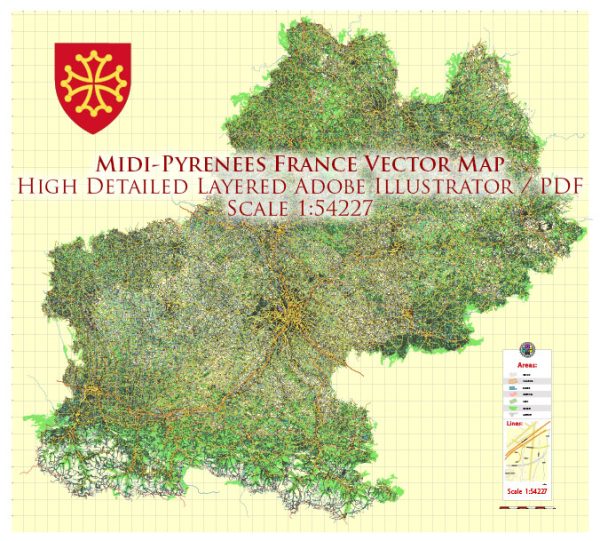The Midi-Pyrénées region in France has a rich history of urban development that spans many centuries. In 2016, the Midi-Pyrénées region merged with the Languedoc-Roussillon region to form the new administrative region of Occitanie. However, for the purpose of this description, we’ll focus on the historical urban development of the Midi-Pyrénées region.
- Roman Influence (1st century BCE – 5th century CE): The region, like much of France, was part of the Roman Empire. Roman cities and infrastructure, such as roads, were established during this period. Toulouse, the capital of the region, was known as Tolosa and became an important Roman city.
- Medieval Period (5th century – 15th century): Following the fall of the Roman Empire, the Midi-Pyrénées region experienced a period of instability and invasions by various groups, including Visigoths and Moors. In the medieval period, the development of fortifications and castles became prominent. Many towns, including Carcassonne, were fortified during this time to protect against invasions.
- Cathar Movement (12th century): The Midi-Pyrénées region was a stronghold for the Cathars, a Christian religious group that challenged the authority of the Catholic Church. The Albigensian Crusade (1209–1229) was launched against the Cathars, leading to the destruction of many Cathar strongholds in the region.
- Renaissance and Early Modern Period (15th century – 18th century): During the Renaissance, trade and commerce flourished in the region. Toulouse, in particular, became known for its cultural and economic vibrancy. The Canal du Midi, a significant engineering feat connecting the Garonne River to the Mediterranean Sea, was constructed in the 17th century, facilitating transportation and trade.
- Industrial Revolution (19th century): The industrial revolution had a significant impact on urban development. Toulouse, with its aerospace industry, emerged as an important industrial center. The city expanded, and new infrastructure, including railways, contributed to economic growth.
- 20th Century: The Midi-Pyrénées region continued to evolve in the 20th century. Toulouse, in particular, became a hub for the aerospace and aviation industries, hosting companies like Airbus. Urbanization and modernization continued, with new developments in transportation, education, and technology.
- Contemporary Period: The merger of Midi-Pyrénées with Languedoc-Roussillon in 2016 formed the Occitanie administrative region. This restructuring aimed at administrative efficiency and regional development. Cities like Toulouse continue to be dynamic economic and cultural centers.
Throughout its history, the Midi-Pyrénées region has experienced shifts in power, cultural influences, and economic activities, all of which have left their mark on the urban development of the area. The region’s cities and towns reflect a diverse and layered history that contributes to the cultural richness of Occitanie.


 Author: Kirill Shrayber, Ph.D.
Author: Kirill Shrayber, Ph.D.